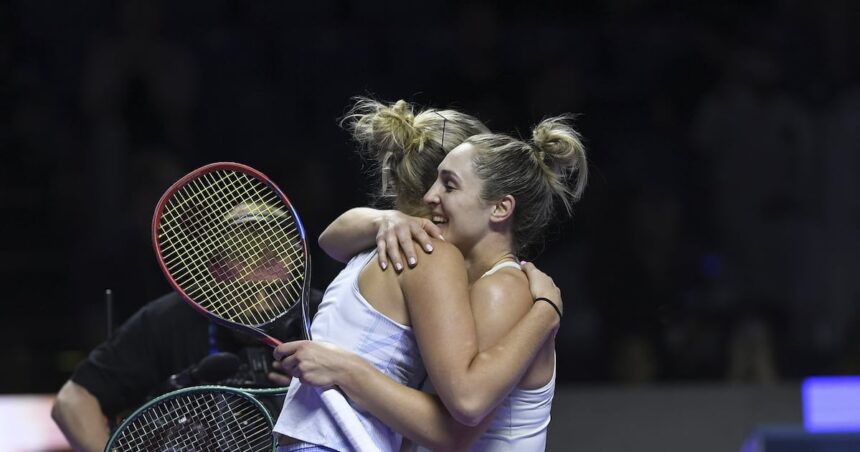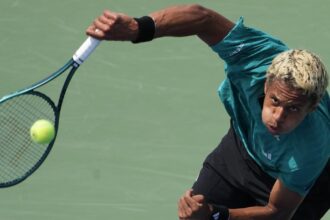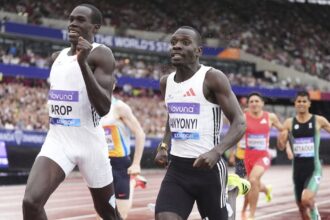In the storied corridors of the All England Club, where tradition meets athletic excellence, Canadian tennis continues to leave its mark on the hallowed grass courts of Wimbledon. Ottawa’s Gabriela Dabrowski and her New Zealand partner Erin Routliffe have successfully punched their ticket to the third round of women’s doubles competition, further cementing Canada’s growing reputation in the tennis world.
The fourth-seeded duo displayed remarkable composure yesterday, overcoming a spirited challenge from Romania’s Monica Niculescu and Ukraine’s Dayana Yastremska with a decisive 6-4, 6-2 victory. Their performance wasn’t merely about winning—it was a masterclass in doubles strategy, showcasing the chemistry that has made them one of the most formidable pairs in the tournament.
What makes this advancement particularly meaningful is the context of Canadian tennis’s evolution. Just two decades ago, the idea of Canadian players consistently reaching late stages of Grand Slam tournaments seemed aspirational at best. Today, it’s becoming something of an expectation, a testament to Tennis Canada‘s developmental programs and the tenacity of players like Dabrowski.
The Ottawa native’s journey deserves special attention. At 33, Dabrowski has become a doubles specialist whose tactical intelligence and net presence have earned her respect across the professional circuit. Her partnership with Routliffe, while relatively new, has already yielded impressive results, building on Dabrowski’s previous Grand Slam success in mixed doubles.
“There’s something about the grass that brings out our best tennis,” Dabrowski remarked after their victory. “The surface rewards precision and quick thinking—exactly the elements we’ve been focusing on in training.”
Meanwhile, on the men’s side, Montreal’s Félix Auger-Aliassime continues his singles campaign with growing confidence. After a challenging year navigating injuries and form fluctuations, his performance at Wimbledon suggests a player finding his rhythm at precisely the right moment. The 24-year-old’s powerful serve becomes particularly dangerous on grass, where the lower bounce amplifies his already formidable weapon.
The Canadian contingent at Wimbledon 2025 represents more than just individual ambitions; it reflects a tennis culture that has matured significantly. From Bianca Andreescu’s breakthrough U.S. Open victory in 2019 to Denis Shapovalov’s flair and Leylah Fernandez’s fighting spirit, Canadian tennis has developed a distinctive identity on the global stage—one characterized by versatility, determination, and sportsmanship.
For Canadian tennis enthusiasts, this Wimbledon offers multiple narratives to follow. Beyond the immediate results lies a deeper story about sporting legacy and national pride. Each match won at this prestigious tournament further normalizes Canadian excellence in a sport historically dominated by other nations.
As Dabrowski and Routliffe prepare for their third-round challenge, they carry not just their own aspirations but the continued evolution of Canadian tennis’s international standing. Their next opponents, Spain’s Cristina Bucsa and Alexandra Panova, present a different stylistic challenge—one that will test the adaptability that has become a hallmark of Dabrowski’s doubles approach.
The grass court season, brief but consequential in the tennis calendar, has historically been challenging for players raised on North American hard courts. Yet Canadian players have increasingly shown the versatility to adjust their games to the unique demands of this surface, where points develop more quickly and movement requires specialized technique.
For the growing community of Canadian tennis followers watching from neighborhood clubs in Toronto, Vancouver, Montreal, and beyond, these Wimbledon performances provide both inspiration and validation. Each victory at SW19 strengthens the connection between grassroots participation and elite success, creating a virtuous cycle that promises to sustain Canadian tennis’s momentum for years to come.
As Wimbledon enters its middle weekend—traditionally a pivotal moment in the tournament’s narrative—Canadian tennis finds itself not merely participating but actively shaping the story of this Grand Slam. For a nation whose tennis history is still being written, that represents a triumph worth celebrating, regardless of what the final scoreboard ultimately shows.
























